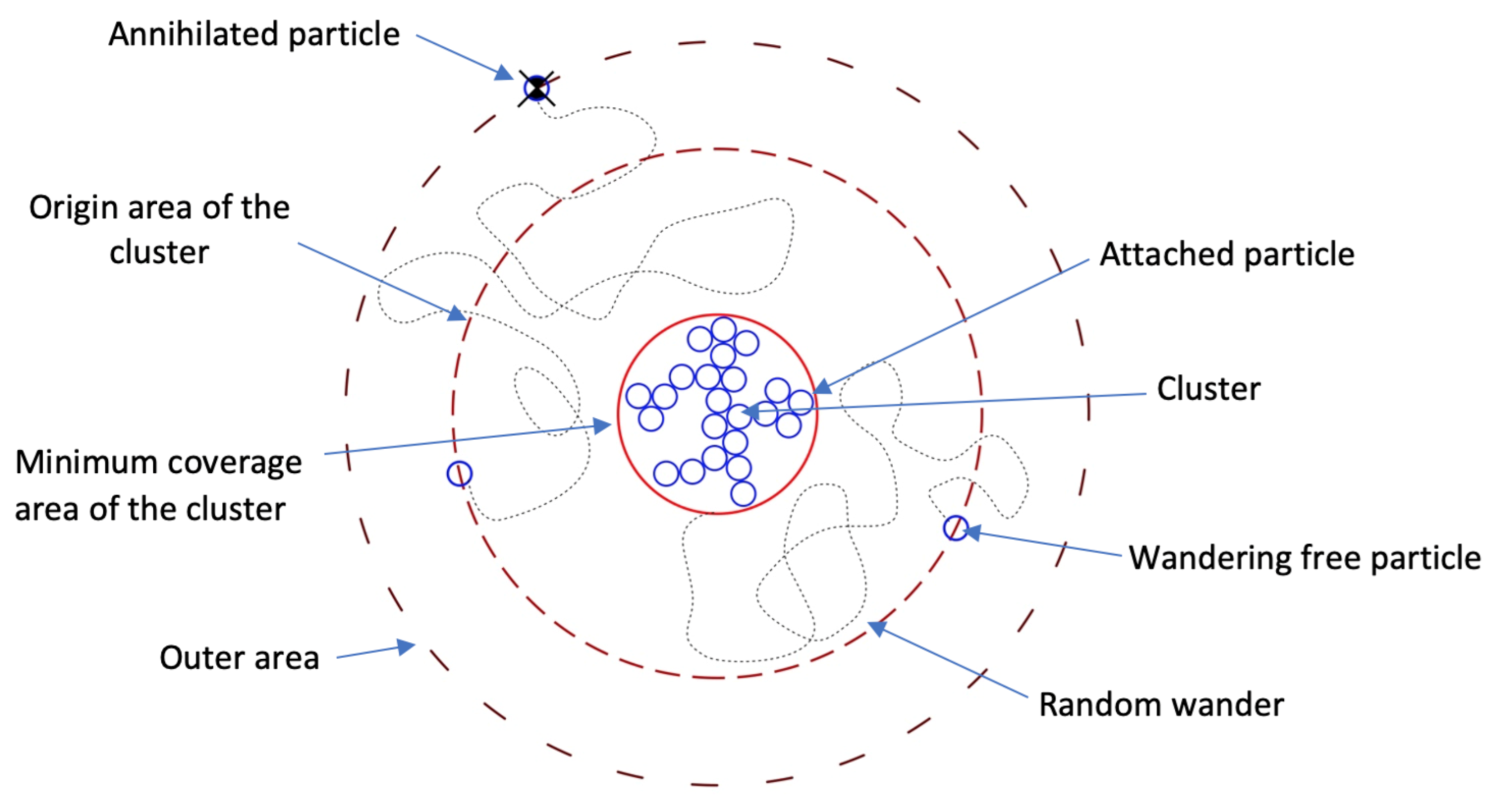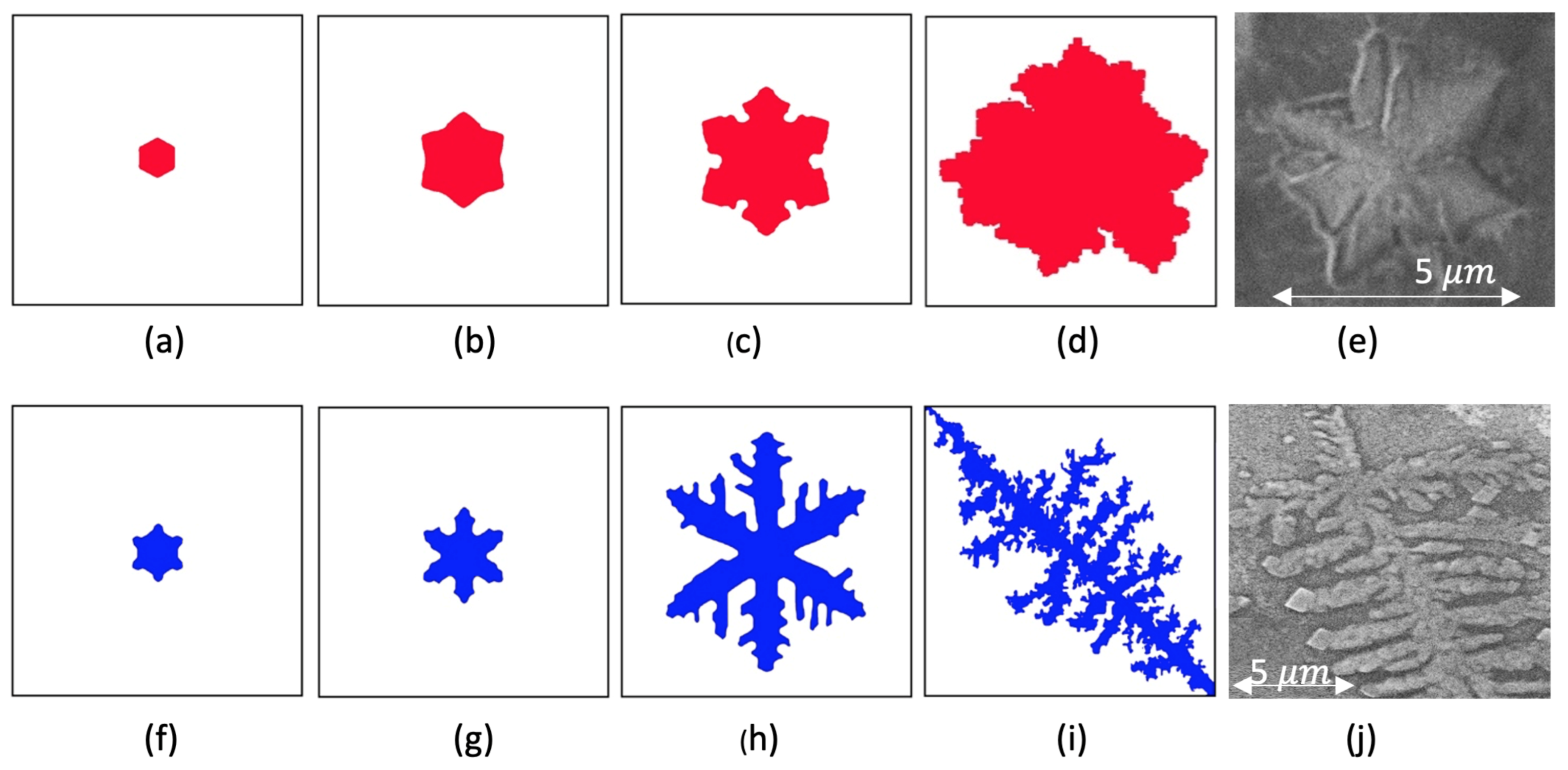Formation of Fractal Dendrites by Laser-Induced Melting of Aluminum Alloys
Abstract
1. Introduction
2. Materials and Methods
3. Results
3.1. The Surface Modification under Laser Action
3.2. Crystal Growth Features
3.3. Model of Dendrite Growth
4. Results and Discussion
5. Conclusions
Author Contributions
Funding
Data Availability Statement
Conflicts of Interest
Abbreviations
| SEM | Scanning Electron Microscopy |
| NPs | Nanoparticles |
| HSLA | High-strength low-alloy steel |
| FAST | Field-assisted sintering technique |
| EDAX | Energy-dispersive X-ray analyzer |
| DLA | Diffusion-limited agglomeration |
| NIR | Near-infrared spectral range |
References
- Dursun, T.; Soutis, C. Recent developments in advanced aircraft aluminium alloys. Mater. Des. 2014, 56, 862–871. [Google Scholar] [CrossRef]
- Figueroa, R.; Abreu, C.M.; Cristóbal, M.J.; Pena, G. Effect of nitrogen and molybdenum ion implantation in the tribological behavior of AA7075 aluminum alloy. Wear 2012, 276–277, 53–60. [Google Scholar] [CrossRef]
- Onate, J.I.; Alonso, F.; García, A. Improvement of tribological properties by ion implantation. Thin Solid Films 1998, 317, 471–476. [Google Scholar] [CrossRef]
- Zhang, F.Y.; Yan, M.F. Microstructure and mechanical properties of multiphase coating produced by plasma nitriding Ti coated GB-5083 aluminum alloy. Surf. Coat. Technol. 2014, 253, 268–276. [Google Scholar] [CrossRef]
- Miotello, A.; Ossi, P.M. Laser-Surface Interactions for New Materials Production; Springer: New York, NY, USA, 2010; Volume 130, pp. 1–17. [Google Scholar]
- Peyre, P.; Fabbro, R. Laser shock processing: A review of the physics and applications. Opt. Quantum Electron 1995, 27, 1213–1229. [Google Scholar]
- Li, L. The advances and characteristics of high-power diode laser materials processing. Opt. Lasers Eng. 2000, 34, 231–253. [Google Scholar] [CrossRef]
- Wang, Z.; Oliveirac, J.P.; Zengd, Z.; Bub, X.; Pengd, B.; Shao, X. Laser beam oscillating welding of 5A06 aluminum alloys: Microstructure, porosity and mechanical properties. Opt. Laser Technol. 2019, 111, 58–65. [Google Scholar] [CrossRef]
- Ke, W.; Bu, X.; Oliveirac, J.P.; Xu, W.; Wang, Z.; Zeng, Z. Modeling and numerical study of keyhole-induced porosity formation in laser beam oscillating welding of 5A06 aluminum alloy. Opt. Laser Technol. 2021, 133, 106540–106550. [Google Scholar] [CrossRef]
- Wang, X.; Zhang, L.C.; Fang, M.H.; Sercombe, T.B. The effect of atmosphere on the structure and properties of a selective laser melted Al–12Si alloy. J. Mater. Sci. Eng. A 2014, 597, 370–375. [Google Scholar] [CrossRef]
- Schaffer, G.B.; Hall, B.J.; Bonner, S.J.; Huo, S.H.; Sercombe, T.B. The effect of the atmosphere and the role of pore filling on the sintering of aluminium. J. Acta Mater. 2006, 54, 131–138. [Google Scholar] [CrossRef]
- Schaffer, G.B.; Hall, B.J. The influence of the atmosphere on the sintering of aluminum. Metall. Mater. Trans. A 2002, 66, 3279–3284. [Google Scholar] [CrossRef]
- Sroka, M.; Jonda, E.; Pakieła, W. Laser Surface Modification of Aluminium Alloy AlMg9 with B4C Powder. Materials 2020, 13, 402. [Google Scholar] [CrossRef]
- Zhao, Y.; Wang, L.; He, W. Effect of Scanning Speed on the Interface Behavior and Dendrite Growth of Laser Remelted Fe-Based Ni/WC Coatings. Coatings 2019, 9, 677. [Google Scholar] [CrossRef]
- Yuan, Y.Z.; Zhu, Y.L.; Liu, Z.Y.; Chuang, Y.Z. Laser remelting of flame sprayed Al2O3 ceramic coatings and subsequent wear resistance. Mater. Sci. Eng. A 2000, 291, 168–172. [Google Scholar]
- Kik, T. Heat Source Models in Numerical Simulations of Laser Welding. Materials 2000, 13, 2653. [Google Scholar] [CrossRef]
- Dubourg, L.; Pelletier, H.; Vaissiere, D.; Hlawka, F.; Cornet, A. Mechanical characterisation of laser surface alloyed aluminium–copper systems. Wear 2002, 253, 1077–1085. [Google Scholar] [CrossRef]
- Quazi, M.M.; Fazal, M.A.; Haseeb, A.S.M.A.; Yusof, F.; Masjuki, H.H.; Arslan, A. Laser-based Surface Modifications of Aluminum and its Alloys. Crit. Rev. Solid State Mater. Sci. 2016, 41, 106–131. [Google Scholar] [CrossRef]
- Youssef, Y.M.; Dashwood, R.J.; Lee, P.D. Effect of clustering on particle pushing and solidification behaviour in TiB2 reinforced aluminium PMMCs. Compos. Part Appl. Sci. Manuf. 2005, 36, 747–763. [Google Scholar] [CrossRef]
- Kim, J.; Rohatgi, P. An analytical solution of the critical interface velocity for the encapturing of insoluble particles by a moving solid/liquid interface. Metall. Mater. Trans. 1998, 29, 351–358. [Google Scholar] [CrossRef]
- Gu, D.; Ma, C.; Xia, M.; Dai, D.; Shi, Q. A multiscale understanding of the thermodynamic and kinetic mechanisms of laser additive manufacturing. Engineering 2017, 3, 675–684. [Google Scholar] [CrossRef]
- Sekerka, R.F. Morphological stability. J. Cryst. Growt 1968, 3–4, 71–74. [Google Scholar] [CrossRef]
- Haxhimali, T.; Karma, A.; Gonzales, F.; Rappaz, M. Orientation selection in dendritic evolution. Nat. Mater. 2006, 5, 660–664. [Google Scholar] [CrossRef] [PubMed]
- Zhmakin, A.I. Simulation of Single Crystal Growth: Heat and Mass Transfer. arXiv 2015, arXiv:1511.07161. [Google Scholar]
- Obuhov, A.A.; Lebedev, V.G. Mathematical modeling of of directed growth of Ni-Al dendrites in non-isothermal conditions. J. Chem. Phys. Mesoscopy 2017, 19, 39–49. [Google Scholar]
- Kobayashi, R. Modeling and numerical simulations of dendritic crystal growth. Phys. D Nonlinear Phenom. 1993, 3–4, 410–423. [Google Scholar] [CrossRef]
- Sanal, R. Numerical Simulation of Dendritic crystal growth using phase field method and investigating the effects of different physical parameter on the growth of the dendrite. arXiv 2014, arXiv:1412.3197. [Google Scholar]
- Keppens, K.; Tóth, G.; Botchev, M.A.; Van der Ploeg, A. implicit and semi-implicit schemes Algorithms. Int. J. Numer. Methods Fluids 1999, 30, 335–352. [Google Scholar] [CrossRef]
- Mroczka, J.; Woźniak, M.; Onofri, F.R.A. Algorithms and methods for analysis of the optical structure factor aggregate. J. Metrol. Meas. Syst. 2012, 3, 459–470. [Google Scholar] [CrossRef]
- Gonzato, G. A practical implementation of the box counting algorithm. Comput. Geosci. 1998, 24, 95–100. [Google Scholar] [CrossRef]



Publisher’s Note: MDPI stays neutral with regard to jurisdictional claims in published maps and institutional affiliations. |
© 2021 by the authors. Licensee MDPI, Basel, Switzerland. This article is an open access article distributed under the terms and conditions of the Creative Commons Attribution (CC BY) license (https://creativecommons.org/licenses/by/4.0/).
Share and Cite
Kucherik, A.; Samyshkin, V.; Prusov, E.; Osipov, A.; Panfilov, A.; Buharov, D.; Arakelian, S.; Skryabin, I.; Kavokin, A.V.; Kutrovskaya, S. Formation of Fractal Dendrites by Laser-Induced Melting of Aluminum Alloys. Nanomaterials 2021, 11, 1043. https://doi.org/10.3390/nano11041043
Kucherik A, Samyshkin V, Prusov E, Osipov A, Panfilov A, Buharov D, Arakelian S, Skryabin I, Kavokin AV, Kutrovskaya S. Formation of Fractal Dendrites by Laser-Induced Melting of Aluminum Alloys. Nanomaterials. 2021; 11(4):1043. https://doi.org/10.3390/nano11041043
Chicago/Turabian StyleKucherik, Alexey, Vlad Samyshkin, Evgeny Prusov, Anton Osipov, Alexey Panfilov, Dmitry Buharov, Sergey Arakelian, Igor Skryabin, Alexey Vitalievich Kavokin, and Stella Kutrovskaya. 2021. "Formation of Fractal Dendrites by Laser-Induced Melting of Aluminum Alloys" Nanomaterials 11, no. 4: 1043. https://doi.org/10.3390/nano11041043
APA StyleKucherik, A., Samyshkin, V., Prusov, E., Osipov, A., Panfilov, A., Buharov, D., Arakelian, S., Skryabin, I., Kavokin, A. V., & Kutrovskaya, S. (2021). Formation of Fractal Dendrites by Laser-Induced Melting of Aluminum Alloys. Nanomaterials, 11(4), 1043. https://doi.org/10.3390/nano11041043






